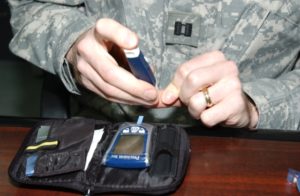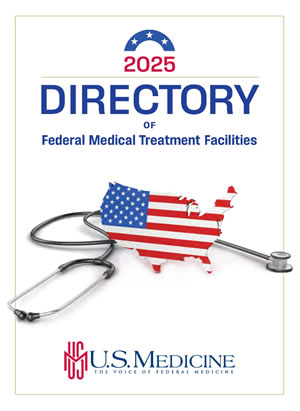
Some servicemembers are able to remain on active-duty with diabetes. In this 2007 photo, a soldier serving in Kuwait checks his blood sugar manually. Army photo by Spc. Wesley Landrum of the 50th Public Affairs Detachment
FORT BRAGG, NC — You can’t join the service with diabetes, so why should the DoD care about monitoring blood sugar in those diagnosed with the disease?
Surprisingly, 2% to 3% of active duty service members have diabetes. Not only can some diabetics stay in the service, they may even be deployed following medical board evaluation.
Some servicemembers will develop type 1 diabetes, formerly known as juvenile diabetes. The cause of type 1 diabetes remains unclear, but it likely has viral, environmental and genetic components. In type 1, something triggers an attack on the pancreas by the immune system, wiping out the beta cells that make insulin.
“When a U.S. Army soldier is diagnosed with type 1 diabetes, it is widely assumed that they will be found unfit for duty and their military career is over,” according to researchers at Womack Army Medical Center at Fort Bragg, NC. “For highly motivated soldiers, current advanced technologies allow the possibility of not only retention on active duty, but military deployment.”1
Most servicemembers, like 95% of other adults who develop diabetes, will have type 2, which is less often career-ending. In type 2 diabetes, the body develops resistance to insulin or fails to produce sufficient insulin to keep glucose levels normal.
According to the CENTCOM minimal standards of fitness for deployment, waivers are required for deployment of all type 1 diabetics and type 2 diabetics on insulin or with HbA1c over 7.0 mg/dl. Servicemembers with stable type 2 diabetes that is managed with lifestyle modifications or oral medications only and who have HbA1c of 7.0 or less do not need a waiver as long as their calculated 10-year coronary heart disease risk is less than 15%.
A medical board evaluation might determine that an individual on insulin could stay in the service or even deploy, if their skill sets are unique and their disease well controlled. For those service members, the need to maintain unit readiness creates an incentive to help them manage their blood glucose levels.
The Fort Bragg team and others have demonstrated that continuous glucose monitoring systems (CGMS) and rigorous training in diabetes management enabled retention of about 35% of service members who developed type 1 diabetes. Of those, nearly 25% successfully deployed.
Continuous glucose monitors help individuals with diabetes better manage their disease by providing readings of their blood glucose to a mobile app with updates every few minutes throughout the day and night. Where self-monitoring of blood glucose (SMBG) requires multiple finger pricks through the day to maintain good control, CGMs use a sensor that is inserted by an automatic applicator just below the skin so it can measure glucose in the interstitial fluid. The sensor transmits real-time readings to a receiver or compatible smart device. Custom alerts let people with diabetes know when their glucose levels are too high or too low.
Simplified Criteria
Until the beginning of this year, continuous glucose monitoring systems were available only for servicemembers with type 1 diabetes who met strict criteria for poorly controlled diabetes. At the time, physicians had to extensively document significant issues caused by the individuals hyper- or hypoglycemia. In most cases, the devices could only be used intermittently with use restricted to three days at a time and not more than six times in year.
The current policy expands “coverage of continuous glucose monitoring systems to therapeutic devices and to modernize the indications for which [continuous glucose monitoring systems] CGMS may be cost shared to ensure they align with best clinical practice,” according to a Defense Health Agency (DHA) report to the Senate Armed Services Committees. Therapeutic devices replace fingerstick blood glucose monitoring; those that require fingersticks are considered adjunctive devices.
“DHA estimates that the cost of adding CGMS for type 2 diabetes will be approximately $8 million over 5 years,” according to the report. “This estimate does not take into consideration the decrease in health care expenditures that may result from improved glycemic control.”
The cost savings could be substantial given the risks associated with poorly controlled diabetes. “Diabetics using tools like CGMS have fewer complications and better control over their disease,” the report noted. “Poorly controlled diabetes, regardless of the type (e.g., Type 1 or Type 2), can result in significant morbidity, to include weakness and dizziness, tremors, palpitations, delirium, confusion, seizures, coma, increased thirst, increased urination, weight loss, lethargy, and secondary conditions such as atherosclerosis, vision problems or blindness, kidney-related complications, and nerve damage.”
Under the updated guidance, TRICARE covers continuous glucose monitoring for all types of diabetes and requires much less onerous documentation for servicemembers, their dependents, and retirees. The new policy includes all continuous glucose monitoring devices approved by the U.S. Food and Drug Administration.
The prescribing physician must document that the individual has had difficulty achieving diabetic control despite at least three daily insulin injections or insulin pump therapy with blood glucose self-testing at least four times a day and completion of a diabetic education program. The patient must also have seen a provider for diabetes control within the previous six months.
To qualify for the devices, patients must have at least one of the following:
-
HBA1c levels greater than 7.0% or less than 4.0%
-
a history of significant, unexplained fluctuations in daily glucose levels prior to meals
-
early morning fasting hyperglycemia
-
a history of severe glycemic fluctuations
-
hypoglycemic unawareness, nocturnal hypoglycemia or a history of unexplained, severe hypoglycemic events with blood glucose levels below 50 mg/dl
-
recurrent episodes of ketoacidosis or hospitalizations for uncontrolled glucose levels
-
pregnancy with poorly controlled diabetes or gestational diabetes.
- Choi YS, Cucura J. US Army Soldiers With Type 1 Diabetes Mellitus. J Diabetes Sci Technol. 2018;12(4):854-858. doi:10.1177/1932296818767700


